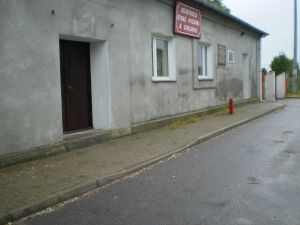Franz Schalling - Guard at Chelmno
Chelmno -Former Deutsches Haus 2009
First explain to me how you came to Kulmhof, to Chelmno. You were at Lodz, right?
In Lodz, yes. In Litzmannstadt.We were on permanent guard duty. Protecting military objectives: mills, the roads when Hitler went to East Prussia. It was dreary, and we were told,
“We need men who want to break out of this routine.”
So we volunteered. We were issued winter uniforms, overcoats, fur hats, fur lined boots, and two or three days later we were told:
“We’re off!”
We were put aboard two or three trucks….. I don’t know….. they had benches, and we rode and rode. Finally, we arrived. The place was crawling with SS men and police. Our first question was
“What goes on here?”
They said,
“You’ll find out.”
You weren’t in the SS, you were…
Police
Which police?
Security guards
We were told to report to the Deutsches Haus, German headquarters, the only big stone building in the village. We were taken into it. An SS man immediately told us, “This is a top-
Secret?
“A top-
Sign this!”
We each had to sign. There was a form ready for each of us, a pledge of secrecy. We never even got to read it through.
You had to take an oath?
No, just sign, promising to shut up about whatever we’d see. Not say a word. After we’d signed, we were told,
“Final solution of the Jewish question.”
We didn’t understand what that meant. It all looked normal.
So someone said…..
He told us what was going to happen there.
Someone said, “The Final Solution of the Jewish question.” You’d be assigned to the “Final Solution?”
Yes, but what did that mean? We’d never heard that before. So it was explained to us.
Just when was this?
Let’s see….. when was it…?
In the winter of 1941-
Then we were assigned to our stations. Our guard post was at the side of the road, a sentry box in front of the castle.
So you were in the castle detail?
That’s right
Can you describe what you saw?
We could see. We were at the gatehouse. When the Jews arrived, the way they looked. Half frozen, starved, dirty, already half-
“You’re going to be deloused and have a bath. You’re going to work here.”
The Jews consented. They said, “Yes, that’s what we want to do.”
Was the castle big?
Pretty big, with huge front steps
The SS man stood at the top of the steps.
Then what happened?
They were hustled into two or three big rooms on the first floor. They had to undress, give up everything, rings, gold, everything.
How long did the Jews stay there?
Long enough to undress.Then stark naked, they had to run down more steps to an underground corridor that led back up to the ramp, where the gas van awaited them.
Did the Jews enter the van willingly?
No, they were beaten. Blows fell everywhere, and the Jews understood. They screamed. It was frightful! Frightful! I know because we went down to the cellar when they were all in the van. We opened the cells of the work detail, the Jewish workers who collected stuff thrown into the yard out of a first-
Describe the gas vans
They stretched say, from here to the window. Just big trucks, like moving vans, with two rear doors.
What system was used? How did they kill them?
With exhaust fumes. It went like this. A Pole yelled “Gas,” then the driver got under the van to hook up the pipe that fed the gas into the van.
Yes, but how?
From the motor
Yes, but through what?
A pipe – a tube. He fiddled around under the truck. I’m not sure how.
It was just exhaust gas?
That’s all.
Who were the drivers?
SS men: All those men were SS.
Were there many of these drivers?
I don’t know.
Were there two, three, five, ten?
Not that many. Two or three, that’s all. I think there were two vans, one big, one smaller.
Did the driver sit in the cab of the van?
Yes. He climbed into the cab after the doors were shut and started the motor.
Did he race the motor?
I don’t know.
Could you hear the sound of the motor?
Yes, from the gate we could hear it turn over
Was it a loud noise?
The noise of a truck engine.
The van was stationary while the motor ran?
That’s right. Then it started moving. We opened the gate and it headed for the woods.
Were the people already dead?
I don’t know it was quiet. No more screams. You couldn’t hear anything as they drove by.
Sources
Shoah – An Oral History of the Holocaust – Claude Lanzmann – published by Pantheon Books New York 1985
Photograph – Chris Webb Archive
© Holocaust Historical Society 2014


